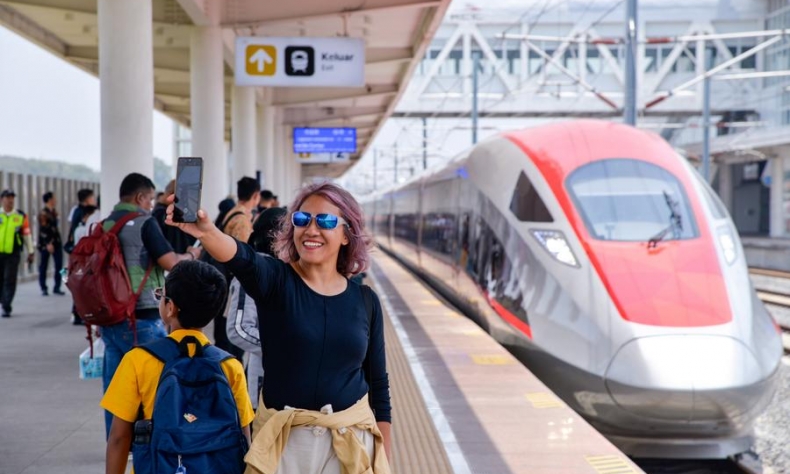A Bond for the Ages

Rooted in profound history that pulls focus to the cultural sector, China-Indonesia people-to-people exchanges have been expanding to a wider range of fields and reached deeper levels.
China and Indonesia enjoy a long history of cultural and people-to-people exchanges.
China’s porcelain and silk and Indonesia’s spices and wood were traded along the Maritime Silk Road since the Han Dynasty (202 BC-AD 220). During the Ming Dynasty (1368-1644), legendary Chinese explorer Zheng He brought Chinese silk, porcelain, and culture to Indonesia during his seven epic voyages. Historical sites and memories about Zheng He have been preserved in many places of Indonesia to this day. Originally established by Zheng He, Sam Poo Kong Temple in Semarang, Central Java, Indonesia, remains a symbol of friendly ties between the Chinese and Indonesian peoples. With the arrival of immigrants from the southern provinces of China to Indonesia, celebration of the Chinese New Year, dragon and lion dances, and other Chinese folk traditions began to take root, kindling the emergence of the Peranakan culture as a blend of Chinese Hokkien and Hakka cultures with local cultures.
Since the establishment of diplomatic relations in 1950, China and Indonesia have been strengthening their ties. Thanks to the implementation of the Belt and Road Initiative (BRI), the two sides have carried out closer exchange in the fields of culture, education, tourism, and art. Digital cooperation has also injected new impetus to personnel exchange between the two countries.
This year marks the 75th anniversary of China-Indonesia diplomatic relations. The fruits of exchange in both traditional and pop cultures have been contributing to the construction of a community with a shared future for China and Indonesia at a higher level.
Fruitful results
Riding the wave of the BRI, China-Indonesia cultural and personnel exchanges have delivered fruitful results in language learning, education, arts, and tourism and opened up more opportunities for mutually beneficial cooperation between the two countries.
Language is a bridge between peoples, and learning each other’s languages has become a popular trend in China and Indonesia. The Confucius Institutes at the Jakarta Chinese Language Teaching Center and the State University of Surabaya have developed into an important platform for promoting Chinese language and culture in Indonesia, while Chinese higher education institutions like Peking University and Guangdong University of Foreign Studies offer Indonesian language programs. China has also welcomed an increasing number of international students from Indonesia.

Educational cooperation between the two countries has expanded at multiple levels. In joint education programs, Beijing Foreign Studies University and the University of Indonesia launched a Chinese language and regional studies dual degree program, and a “2+2” program was established by Huazhong University of Science and Technology and Bandung Institute of Technology. Joint research between Tsinghua University and the University of Indonesia in public health and other areas has continued to deepen. In school-enterprise cooperation, the Master’s program in metallurgy engineering for international students at Central South University of China has trained about 100 professionals for Indonesia’s new energy industry, and 40 Chinese companies and more than 50 Indonesian universities participated in business matching during the Indonesia Education-China Industry Talk 2024 held in Jakarta.
Exchange in the arts has also proved productive. The film Tsunami, co-produced by China and Indonesia, tells the story of a Chinese rescue team participating in the 2004 Indian Ocean tsunami rescue operations. The documentary Maritime Silk Road: Close Friends Far Apart, another China-Indonesia co-production, presents the synergy between China-proposed BRI and Indonesia’s Global Maritime Fulcrum strategy. Joint performances and exhibitions, as well as dialogues between Chinese and Indonesian artists, inspired the filmmakers to take a refreshing approach to traditional art forms.
Tourism cooperation has facilitated people-to-people interactions. Many Chinese people have enjoyed tropical island scenery in Indonesia thanks to visa-free entry to destinations such as Bali. The China-Indonesia direct flight network covers Chinese cities including Beijing, Shanghai, Guangzhou, and Xiamen and Indonesian cities such as Jakarta, Bali, and Surabaya. Yunnan and Beijing have become the first choice for Indonesian tourists seeking to experience Chinese civilization. Sister-city partnerships and close trade relations between Guangdong and Jakarta and between Fujian and Central Java have strengthened collaboration on economics, trade, culture, and tourism.
Exchange in the digital age
In 2023, China and Indonesia signed a memorandum of understanding on digital economy cooperation, providing a framework for partnership in areas such as data flow and network security. Chinese technology giants Huawei and ZTE have participated heavily in the construction of Indonesia’s 5G network. The data center established by Huawei in Jakarta supported Indonesia’s National Data Center project and helped the country emerge as a regional digital hub. Efficient and convenient, digital technology has fostered in-depth exchanges between the two countries in education, culture, tourism, and other fields.

Digital education has opened up new channels for bilateral cooperation. Online Chinese education platforms such as VIPKid and Yuanfudao provide Chinese courses for Indonesian users. Chinese universities and Indonesian vocational schools jointly developed online courses on the digital economy and e-commerce for Indonesian students. The National Library of China and the University of Indonesia launched cooperation on sharing electronic literature resources.
Social media has transformed youth exchange. With more than 100 million users in Indonesia, TikTok has provided a new alternative for young people from both countries to share culture, food, and travel experiences. Topics like “Chinese Learning Challenge” and “Discovering Indonesian Food” have frequently trended on the platform. An e-education cultural course jointly developed by Huazhong University of Science and Technology and Indonesian colleges attracted more than 400 students from both countries to discuss digitized publicity of cultural heritage online.
Virtual technology has fostered integration of culture and tourism. The Palace Museum of China and the National Museum of Indonesia worked together to display the cultural heritage of the two countries on the internet with the help of virtual reality and augmented reality technologies. Chinese users can visit Indonesian tourist attractions online, while Indonesian visitors can appreciate China’s landmarks such as the Great Wall and the Forbidden City remotely.
Rooted in profound history that pulls focus to the cultural sector, China-Indonesia people-to-people exchanges have been expanding to a wider range of fields and reached deeper levels. Continuously increasing cooperation in creative culture, the green economy, and digital transformation will drive personnel exchanges to be even more inclusive and innovative, injecting new impetus into deepening the comprehensive strategic partnership and building a community with a shared future between the two countries.
Yang Shao is an associate researcher at the China (Kunming) Institute of South and Southeast Asian Studies.
 Facebook
Facebook
 Twitter
Twitter
 Linkedin
Linkedin
 Google +
Google +










